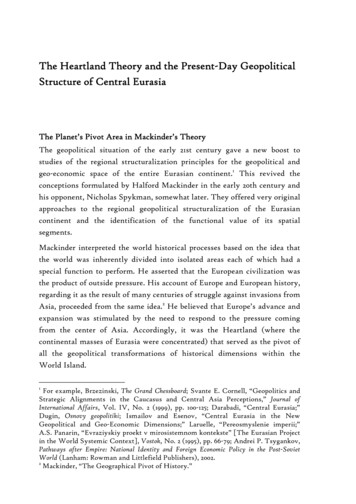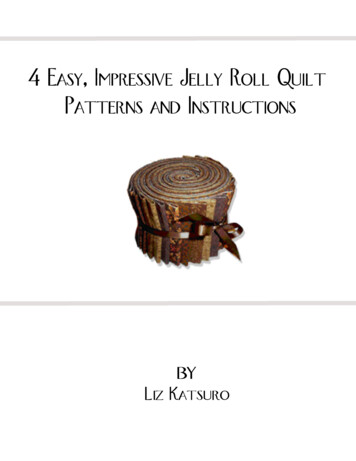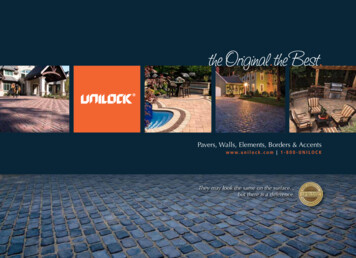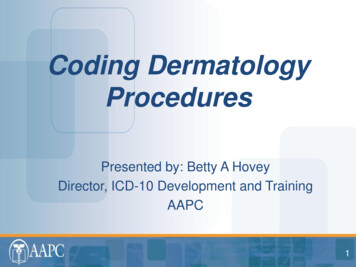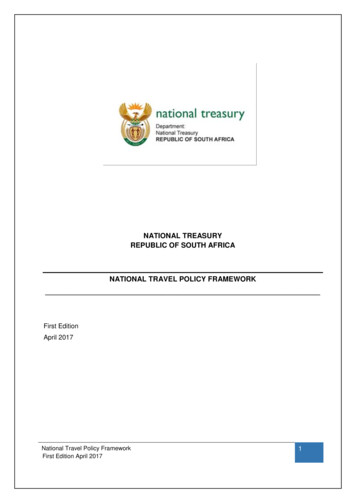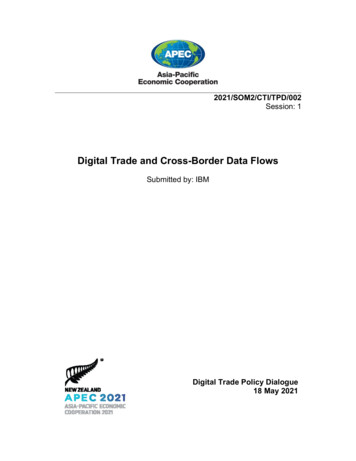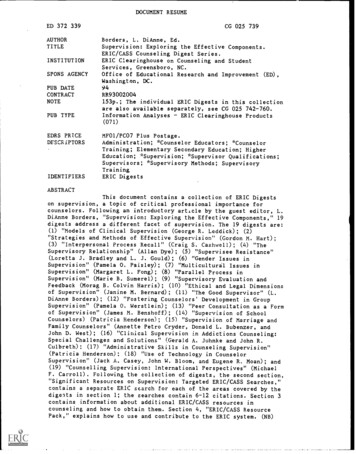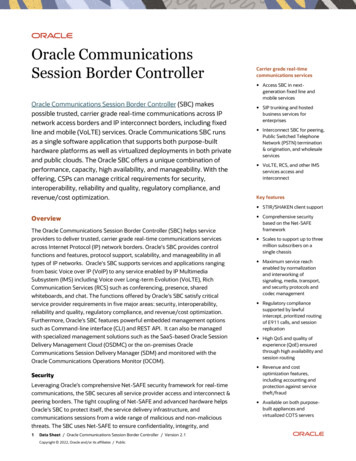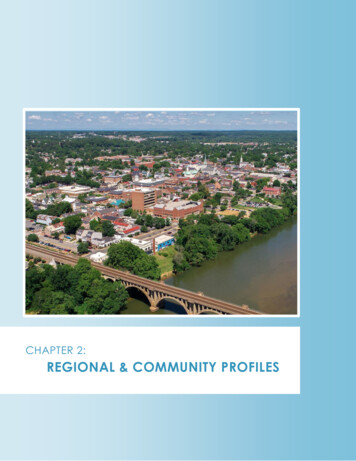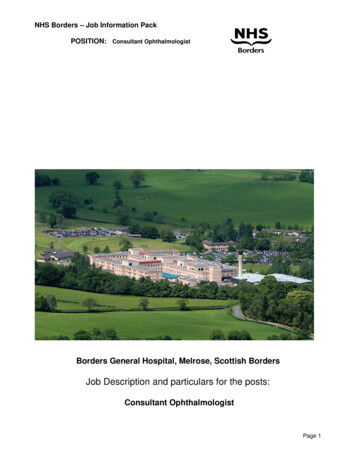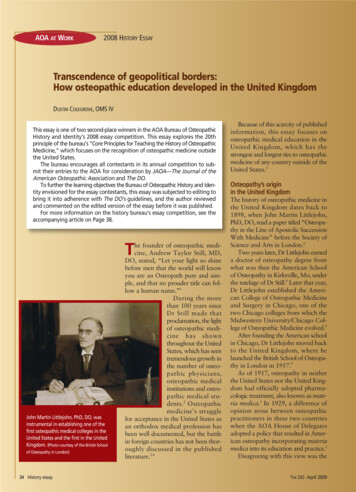
Transcription
AOA AT WORK2008 HISTORY ESSAYTranscendence of geopolitical borders:How osteopathic education developed in the United KingdomDUSTIN COLEGROVE, OMS IVThis essay is one of two second-place winners in the AOA Bureau of OsteopathicHistory and Identity’s 2008 essay competition. This essay explores the 20thprinciple of the bureau’s “Core Principles for Teaching the History of OsteopathicMedicine,” which focuses on the recognition of osteopathic medicine outsidethe United States.The bureau encourages all contestants in its annual competition to submit their entries to the AOA for consideration by JAOA—The Journal of theAmerican Osteopathic Association and The DO.To further the learning objectives the Bureau of Osteopathic History and Identity envisioned for the essay contestants, this essay was subjected to editing tobring it into adherence with The DO’s guidelines, and the author reviewedand commented on the edited version of the essay before it was published.For more information on the history bureau’s essay competition, see theaccompanying article on Page 38.TJohn Martin Littlejohn, PhD, DO, wasinstrumental in establishing one of thefirst osteopathic medical colleges in theUnited States and the first in the UnitedKingdom. (Photo courtesy of the British Schoolof Osteopathy in London)34 History essayhe founder of osteopathic medicine, Andrew Taylor Still, MD,DO, stated, “Let your light so shinebefore men that the world will knowyou are an Osteopath pure and simple, and that no prouder title can follow a human name.”1During the morethan 100 years sinceDr Still made thatproclamation, the lightof osteopathic medicine has shownthroughout the UnitedStates, which has seentremendous growth inthe number of osteopathic physicians,osteopathic medicalinstitutions and osteopathic medical students.2 Osteopathicmedicine’s strugglefor acceptance in the United States asan orthodox medical profession hasbeen well documented, but the battlein foreign countries has not been thoroughly discussed in the publishedliterature.3,4Because of this scarcity of publishedinformation, this essay focuses onosteopathic medical education in theUnited King dom, which has thestrongest and longest ties to osteopathicmedicine of any country outside of theUnited States.5Osteopathy’s originin the United KingdomThe history of osteopathic medicine inthe United Kingdom dates back to1898, when John Martin Littlejohn,PhD, DO, read a paper titled “Osteopathy in the Line of Apostolic SuccessionWith Medicine” before the Society ofScience and Arts in London.6Two years later, Dr Littlejohn earneda doctor of osteopathy degree fromwhat was then the American Schoolof Osteopathy in Kirksville, Mo, underthe tutelage of Dr Still.6 Later that year,Dr Littlejohn established the American College of Osteopathic Medicineand Surgery in Chicago, one of thetwo Chicago colleges from which theMidwestern University/Chicago College of Osteopathic Medicine evolved.6After founding the American schoolin Chicago, Dr Littlejohn moved backto the United Kingdom, where helaunched the British School of Osteopathy in London in 1917.6As of 1917, osteopathy in neitherthe United States nor the United Kingdom had officially adopted pharmacologic treatment, also known as materia medica.3 In 1929, a difference ofopinion arose between osteopathicpractitioners in these two countrieswhen the AOA House of Delegatesadopted a policy that resulted in American osteopathy incorporating materiamedica into its education and practice.3Disagreeing with this view was theTHE DO April 2009
British Osteopathic Association, whichdid not accept the AOA as the ultimateauthority on professional standards.As a result, British practitioners didnot adopt pharmacologic treatmentand instead focused solely on providing patients with manipulative treatment for the osteopathic lesion, whichis now more commonly called somatic dysfunction.It is essential to understand thatosteopathic practitioners in GreatBritain are called osteopaths. Anosteopath is a nonphysician healthcarepractitioner who practices only manip7ulation. In contrast, an Americanosteopathic physician is a practitionerwho is able to prescribe pharmaceuticals and perform surgery in additionto using osteopathic manipulative treatment.7The most important differencebetween osteopaths who train inthe United Kingdom and osteopathicphysicians who train in the UnitedStates is their respective scope ofpractice.7 This difference relates tothe length and type of training thatosteopaths in the United Kingdomreceive.Early osteopathic educationThe British School of Osteopathy wasthe first school in the United Kingdom.Its program was similar to the curriculum at the American School ofOsteopathy, which Dr Still establishedin 1892. Studies at the British School ofOsteopathy included courses in anatomy, physiology, histology, and osteopathic principles and technique.Training at the British School ofOsteopathy thrived under Dr Littlejohn’s guidance as founder, dean andlifelong advocate. His writings andspeeches provide a window into theearly philosophy of the school. His philosophy can be seen in statements suchas the following: “[T]here is physical,anatomical, and physiological diagnosis [that will] always be the ground8work of the Osteopathic system.”While he declared that osteopathicmanipulation is the primary emphasisof osteopathy, he observed that “theOsteopathic system does not look atthe body from a one-sided point ofview, but lays hold of the prominentcharacteristic of the whole organism,vitality.”8The emphasis on osteopathic manipulation and on a holistic, patient-centered approach characterized earlyosteopathic education in the UnitedKingdom. This emphasis is also thebasis for modern schools of osteopathyin the United Kingdom.Even though the British School ofOsteopathy was the first school in theUnited Kingdom, not all British osteopaths trained there. Numerous independent training programs emergeddue to the lack of standardization ofosteopathy in the United Kingdom; theabsence of a single, unifying professional association; and the lack of recognition from the British government.6These programs were often decentralized, offering short courses of only several months in length.6 In contrast,more formal programs took years tocomplete.6In addition, apprentice-based systems developed in which apprenticeswere taught by osteopaths and evenchiropractors.6 Adding to this complexenvironment were practitioners trainedin the United States who brought theirskills to the United Kingdom prior tothe founding of the British School ofOsteopathy.6Widespread curricular variabilityinevitably led to differing levels ofexpertise among British osteopaths.In early 2008, the General OsteopathicCouncil celebrated a decade of regulation ofosteopathy in the United Kingdom byconducting a conference called “AdvancingOsteopathy 2008.”Just prior to the conference’s welcomingreception in Drapers Hall in London, 2008-09AOA President-elect Larry A. Wickless, DO(left), met with David Tredinnick, themember of Parliament who introduced theOsteopaths Act 1993, which led toosteopathy being regulated in the UnitedKingdom four years later. (Photo by Josh Kerr)THE DO April 2009History essay 35
AOA AT WORKThis decentralized training environment characterized osteopathy in theUnited Kingdom until the passage of theOsteopaths Act of 1993.9Standardizing osteopathic educationThe Osteopaths Act of 1993 established the General Osteopathic Council (GOsC), which serves as an accreditation body and provides standardization to the profession in the UnitedKing dom. 10 The GOsC overseesstandards of professional training andconduct, maintains the register ofosteopaths, and deals with deficienciesin practitioner behavior and competency.10Commenting on the Osteopaths Act,an editorial in the British medical journal BMJ stated, “[O]steopathy willthen become the first branch of complementary medicine to be formallyrecognized and regulated in Britain. .It will be illegal for anyone not on thisregister to describe himself or herselfas an osteopath.”10 This act was basedon the model the United Kingdomadopted for the allopathic medical profession in 1858.10 As a consequence,once this bill became law, allopathicphysicians and other healthcare professionals were able to refer patientsto osteopaths with full confidence intheir qualifications.Even though osteopaths gainedrights in the United Kingdom in 1993,it was still impossible for US-trainedosteopathic physicians to prescribemedication or perform surgery aslicensed physicians.7,11 This situationchanged in September 2005, whenUS-trained osteopathic physiciansbecame eligible for full practice rightsin the United Kingdom through theassistance and advocacy of the AOA.5,12With this new policy toward osteopathic medicine, the United Kingdomjoined more than 40 other countriesin offering full practice rights to UStrained osteopathic physicians.7The current regulation for UStrained osteopathic physicians to practice in the United Kingdom is as fol36 History essayImportant events in osteopathic historyin the United KingdomYearAchievement1874Andrew Taylor Still, MD, DO, articulates the fundamental principles ofosteopathic medicine.1892Dr Still establishes the American School of Osteopathy in Kirksville, Mo.1898John Martin Littlejohn, PhD, DO, reads a paper titled “Osteopathy inthe Line of Apostolic Succession With Medicine” before the Society ofScience and Arts in London.1900Dr Littlejohn graduates from the American School of Osteopathy.1900After teaching human anatomy at the American School of Osteopathy, William Smith, MD, DO, returns to the United Kingdom as thefirst osteopathic practitioner.1911The British Society of Osteopaths changes its name to the BritishOsteopathic Association.1917Dr Littlejohn establishes the British School of Osteopathy in London.1935The British School of Osteopathy graduates its 100th student.1946The London College of Osteopathic Medicine is established for thepurpose of training allopathic physicians in osteopathy.1965The European School of Osteopathy moves to London from Paris,where it was established in 1951. The school moves to Maidstone inKent in 1971.1983Some 1,000 to 1,200 osteopaths and osteopathic physicians arepracticing osteopathic manipulation in the United Kingdom.1993Parliament passes the Osteopaths Act, providing much-neededstandardization for the profession.2005US-trained osteopathic physicians are granted full practice rights inthe United Kingdom.2007More than 3,800 osteopaths and osteopathic physicians are practicingin the United Kingdom.lows: “Each applicant will have to passthe Professional Linguistic AssessmentBoard (PLAB) examination and workfor one supervised year in the National Health Service (NHS). Followingthat year, the applicants will be ableto apply for full registration (unsupervised practice or private practice). Forregistration as a specialist, postgraduatetraining will need to be separatelyrecognized by the Postgraduate Medical Education and Training Board12(PMETB).”This landmark development mayappear to have little to do with osteopathic education in the United King-THE DO April 2009
Degrees offered by osteopathic schools in the United KingdomInstitutionUndergraduate degreesBritish College of Osteopathic MedicineDO and MOstBritish School of OsteopathyMOstMSc Osteopathy in the cranial fieldCollege of OsteopathsBSc (Hons) OsteopathyMSc in Professional Studies (Osteopathy),ADO, and postgraduate certificate inclinical studies (osteopathy)European School of OsteopathyBSc (Hons) Osteopathy and MOstMSc OsteopathyLondon College of Osteopathic MedicinePostgraduate degreesMLCOMLondon School of OsteopathyBSc (Hons) Osteopathy and MOstOxford-Brookes University Program of OsteopathyBSc (Hons) Osteopathy andcombined BOst (Hons)/MOstSurrey Institute of Osteopathic Medicineat the North East Surrey College of TechnologyBSc (Hons) Osteopathy and MOstMSc OsteopathyADO advanced diploma in osteopathyBOst (Hons) bachelor of osteopathy honoursBSc (Hons) Osteopathy bachelor of science honours in osteopathyDO diploma of osteopathyMLCOM member of the London College of Osteopathic MedicineMOst integrated master in osteopathyMSc Osteopathy master of science in osteopathyMSc in Professional Studies (Osteopathy) master of science in professional studies in osteopathydom, but it may indicate that osteopathic medical colleges based on theAmerican model may be accepted inthe United Kingdom in the future. Ifany extant or future institutions adoptthe American model of osteopathicmedical education, the face of osteopathy would be forever changed inthe United Kingdom. British School of Osteopathy.Modern osteopathic education European School of Osteopathy inMaidstone in Kent.Osteopathic education in the UnitedKingdom is an important part of global osteopathy due to its 92 years ofhistory and its highly qualified trainingprograms, which are overseen andregulated by the GOsC.10The United Kingdom currently haseight accredited osteopathic institutions:THE DO April 2009 British College of OsteopathicMedicine in London. College of Osteopaths, which hascampuses in Borehamwood in Hertfordshire and at Keele Universityin Keele in Staffordshire. London College of OsteopathicMedicine. London School of Osteopathy. Oxford-Brookes University Program ofOsteopathy in Oxford in Oxfordshire. Surrey Institute of Osteopathic Medicine at the North East Surrey Collegeof Technology in Epson and Ewellin Surrey.Except for the London College ofOsteopathic Medicine, all of theseinstitutions offer under graduatedegree programs in osteopathy. Fourof these also offer postgraduate programs, while the London Collegeof Osteopathic Medicine focuses onproviding postgraduate training inosteopathy to allopathic physicians.In the past, the baccalaureate degreegranted to osteopaths in the UnitedKingdom was the diploma of osteopathy (DO), which has the same initialsas the doctor of osteopathic medicinedegree awarded by osteopathic medicalHistory essay 37
AOA AT WORKHistory essay competition targets five new core principlesTo encourage osteopathic medical students, interns and residents to study theirprofession’s past struggles and achievements, the AOA Bureau of OsteopathicHistory and Identity is conducting its fifthannual history essay competition.As it has done since 2006, the bureauwill bestow up to three cash awards, totaling 10,000.Like last year, the bureau selected thecompetition’s topics from its “Core Principles for Teaching the History of Osteopathic Medicine.” For the 2009 competition, each contestant can choose one ofthe following five principles:Core Principle 2. The fundamental principles and philosophies that underlay theearly practice of osteopathy. (In developing its core principles, the bureau used theterm osteopathy to refer to the profession during the period in which most DOspracticed strictly manipulative medicine.)Core Principle 11. The development ofbasic scientific osteopathic medicalresearch.Core Principle 17. The increasing recognition of the osteopathic medical profession by state and national governmentalagencies.Core Principle 18. The role of the “financing of healthcare” in changing the practiceof osteopathic physicians, including itsimpact on both the number of osteopathichospitals and the number of osteopathicgraduate medical education programs.Core Principle 19. The role of “distinctiveness” in the current practice of osteopathic medicine with respect to definingthe rationale for organizational independence.colleges in the United States.7 As a consequence, osteopaths from Britishschools could be confused with UStrained osteopathic physicians.7 Thiscould unintentionally lead other coun-38 History essayThe bureau included Core Principles11, 17 and 18 among this year’s choicesbecause they resonate with the theme ofAOA President Carlo J. DiMarco, DO,“Leading to Greatness: Initiatives in OGME,Research and Advocacy.”“Advocacy” tab. Then on the “Publications” page, click The DO’s link on the lefthand navigation bar, and select the linksfor the February 2008 and March 2007issues.Peer-reviewed judgingAs in the past four years, this year’s entrieswill undergo peer-review judging bymembers of the Bureau of OsteopathicHistory and Identity.Depending on the quality and quantity of the entries, the history bureau willaward prizes to up to three authors. Thebureau will determine the winning essaysby late summer in time for the winningauthors to plan to attend the 114th Annual AOA Convention and Scientific Seminar, which will be held Nov 1-5 at theErnest N. Morial Convention Center inNew Orleans.In addition to honoring the winners atthe AOA convention, the history bureauwill encourage all contestants to submittheir essays to the AOA for considerationby JAOA—The Journal of the AmericanOsteopathic Association and The DO. Theessays of those contestants who do so mayend up undergoing the JAOA’s own peerreview process.The essay by Dustin Colegrove, OMS IV,that begins of Page 34 of this issue of TheDO is one of the entries from the bureau’s2008 competition that has been accepted for publication by the AOA.For examples of other published essays,students, interns and residents can turnto The DO’s February 2008 and March2007 issues to read the first- and thirdplace entries in the history bureau’s 2006competition. Written by Rhett Papa,OMS IV, and Dana M. Block-Abraham, DO,respectively, those essays can be accessedon DO-Online, located at www.doonline.org. From DO-Online’s home page,click on the “Publications” link under theCompetition detailsThe 2009 essay competition is open to allosteopathic medical students, interns andresidents. The deadline for submittingessays is Monday, June 1.In drafting their essays, contestantsshould consult the JAOA’s “Informationfor Contributors” guidelines for instructions for special communication articles.Those guidelines are posted on the JAOA’sWeb site, which can be accessed throughDO-Online’s “Publications” page. A printversion of “Information for Contributors”can be found in the Journal’s August 2008issue on Page 456.The maximum essay length is 3,000words. The word count should be noted atthe beginning of each essay, as should thecore principle the essay addresses.In addition, essays should be submitted as Microsoft Word documents, using12-point Times New Roman font.Essays can be submitted by e-mail tohistory@osteopathic.org. The subject lineon e-mail messages should be “2009 History Essay Competition.”Alternatively, essays can be mailed tothe Department of Publications, 2009 History Essay Competition, American Osteopathic Association, 142 E Ontario St, Chicago, IL 60611-2864. For mailed entries, essaysneed to be placed on CDs or diskettes.For additional details, contestants canread the article on Pages 28-30 of TheDO’s January issue. That article is availableon DO-Online.Contestants with questions can call(800) 621-1773, ext 8157; send e-mail tohistory@osteopathic.org; or send faxes to(312) 202-8457.—Michael Fitzgeraldtries to underestimate the abilities andskills of US-trained osteopathic physicians.7Fortunately, except for the BritishCollege of Osteopathic Medicine, theBritish schools have abandoned granting the diploma of osteopathy in theirundergraduate programs. However,schools of osteopathy in such countries as Switzerland and New ZealandTHE DO April 2009
still award the diploma of osteopathyto their graduates, thereby perpetuating confusion with regard to the DOdegree.In replacing the diploma of osteopathy as an undergraduate degree, theBritish schools adopted the bachelorof science honours in osteopathy (BSc[Hons] Osteopathy), the bachelor ofosteopathy honours (BOst [Hons]) andthe integrated master of science inosteopathy (MOst). (See the chart onPage 37 for a summary of the degreesoffered by the British schools.) BecauseMOst degrees are considered to beundergraduate degrees, students donot need to obtain a bachelor’s degreebefore entering MOst programs.Baccalaureates require four years tocomplete for full-time students and fiveyears for part-time students.5 A typical full-time undergraduate curriculumin osteopathy consists of basic sciencesfor the first two years and clinical education for the remaining two.13During the first two years, studentsstudy osteopathic principles and practice, anatomy, physiology, pathology,nutrition and spinal mechanics. Someinstitutions require their students tostudy pharmacology so that theyunderstand the pharmaceutical sideeffects they may encounter in the clinical setting.13The last two years are spent obtaining clinical experiences in universityrun clinics, where students actively treatpatients with osteopathic manipulation.14 Students also attend lecturebased courses emphasizing clinicaltheory in psychology, obstetrics, pediatrics and rheumatology. Several institutions require that students completea research project prior to graduation.Insofar as training is concerned, theoverall educational philosophy in theUnited Kingdom focuses on the osteopathic lesion’s function in disease.6This naturally lends itself to trainingthat concentrates on adjustive musculoskeletal procedures, especially becausefull medical practice remains unattainable for British-trained practitioners.THE DO April 2009The European School of Osteopathyand the British School of Osteopathyhave incorporated alternative medicalphilosophies into their curricula, suchas naturopathy, herbal medicine and6yoga. This trend may reflect thatosteopaths in the United Kingdom havea strong link to alternative medicinebecause they are restricted to practicingosteopathic manipulation.3Upon graduating, osteopaths maybegin practice as soon as they registerwith the GOsC. No postgraduate training is required for licensure or practice. However, osteopaths must participate in continuing professional development, which is similar to continuingmedical education in the United States.15Those who want credentials beyondthe baccalaureate level can choose tostart their training in undergraduateMOst programs or continue their studies by earning one of four postgraduatedegrees: the master of science inosteopathy (MSc Osteopathy), themaster of science in professional studies in osteopathy (MSc in ProfessionalStudies [Osteopathy]), the advanceddiploma in osteopathy (ADP) or thepostgraduate certificate in clinicalstudies (osteopathy).Like the baccalaureate programs,MOst programs require four years oftraining. In contrast, MSc Osteopathyprograms require an additional twoyears of osteopathic education. MScOsteopathy programs provide additional training in research and in specialized osteopathic techniques. In addition, graduate students must completea research project and write a dissertation. Students who complete thisadvanced training gain further clinicalcompetency that will help preparethem for a specialized practice or foran academic appointment.Because British-trained osteopathscannot obtain full medical practicerights, a doctoral degree in osteopathyis not an educational option. However,allopathic physicians can obtain training in osteopathy. The London College of Osteopathic Medicine was5founded in 1946 for this purpose.The college’s postgraduate educationprogram consists of 13 months oftraining. After passing their final examinations, allopathic physicians receivethe designation of member of theLondon College of Osteopathic Medicine (MLCOM), and they become eligible to join the Association of MedicalOsteopaths.16Occupational outlookfor British osteopathsThe United Kingdom has embracedalternative therapies in recent years,with as much as 46.6% of the population having received complementarytherapy.17 This has resulted in a steadysupply of patients and a high demandfor osteopathy.17 Contributing to thistrend are British medical doctors whoare referring patients to osteopaths forcare.18 The GOsC states that “an estimated 24,000 patients consultosteopaths every working day . nearlyseven million consultations a year.”19In the United Kingdom, osteopathic practitioners work in solo and grouppractices. Some group practices employan interdisciplinary approach, even tothe point of integrating care from allopathic physicians. For example, theWells Park general practice in Sydenham in South London has integratedosteopathy and acupuncture into a traditional medical practice.18 This typeof healthcare model has been shownto provide better patient outcomes thannonintegrated models.20,21 In addition,osteopathic care is cost-effective in thatit can eliminate the need for expensivetests and invasive procedures.20,21Osteopathy is growing rapidly inthe United Kingdom. In 1983, theUnited Kingdom had roughly 1,000to 1,200 osteopaths.6 As of 2007, atotal of 3,823 osteopaths and osteopathic physicians were registered withthe GOsC, of whom 2,039 were menand 1,784 were women.19Even though the osteopathic profession in the United Kingdom hasmade extraordinary advances, a num-History essay 39
AOA AT WORKber of opportunities remain. For example, a considerable amount of workwould be required for British osteopathsto move toward becoming osteopathic physicians. It is questionable as towhether osteopaths in the United Kingdom would embrace this idea, especially given their long history of practicing manipulative medicine exclusively. However, additional programsare being developed for allopathicphysicians to learn osteopathic medicine. This interest within the “traditional” medical profession indicatesthat there may be opportunities forosteopaths to expand their scope ofpractice by modifying their training.If the osteopathic associations in theUnited Kingdom decided to pursue thiscourse, osteopathic training programswould have to drastically alter theircurricula to include a full range of clinical clerkships, as well as expand theirbasic science course work during thepreclinical years. In addition, Britishosteopaths would have to work tochange the unfavorable legal environment, which restricts their practicerights.References1.Still AT. Address to students and diplomats, May 7th, 1894—Osteopathy adheres to thelaws of nature—Affidavits of medical doctors—Osteopathy can accomplish all things—All or nothing—Stand by the old flag—Osteopathy. In: Autobiography of A.T. Still.Rev ed. Kirksville, Mo: Published by author; 1908:295-300. Available at www.interlinea.org/atstill/Autobiography Revised V2.pdf. Accessed March 26, 2008.2.Shannon SC. Osteopathic medical education in 2008: Course corrections and newhorizons. J Am Osteopath Assoc. 2008;108:100-101. Available at www.jaoa.org/cgi/content/full/108/3/100. Accessed April 7, 2009.3.Gevitz N. The DOs: Osteopathic Medicine in America. 2nd ed. Baltimore: Johns Hopkins UniversityPress; 2004.4.Gray C. Osteopathy: Is there a place in Canadian medicine? Can Med Assoc J. 1981;125:108-111.5.Carreiro, JE. A global snapshot of osteopathic medicine. Osteopathic Family Physician News.May 2006:14-16.6.Baer HA. The drive for professionalization in British osteopathy. Soc Sci Med. 1984;19:717-725.7.Shadday GJ, Papadeas GG, Smith LL. The progression of osteopathic medicine internationally:A survey of America-trained DOs practicing abroad. J Am Osteopath Assoc. 1988;88:1,095-1,098.8.Littlejohn JM. Osteopathy an independent system co-extensive with the science and art ofhealing [reprint from: J Am Osteopath Assoc.1901;1:22-34]. J Am Osteopath Assoc. 2000;100:14-26. Available at www.jaoa.org/cgi/reprint/100/1/14. Accessed March 26, 2009.9.Richmond C. Fighting the odds in the UK. Can Med Assoc J. 1996;154:1,547-1,578.10. Maxwell RJ. The osteopaths bill. BMJ. 1993;306:1,556-1,557.11. Northup GW. Osteopathic medicine in foreign countries. J Am Osteopath Assoc. 1985;85:623-633.12. Division of State and Socioeconomic Affairs. US Osteopathic Licensure Summary, January 2007.Chicago: American Osteopathic Association; 2006.13. MOst content. British School of Osteopathy’s Web site. Available at www.bso.ac.uk/sm2cont.htm.Accessed March 26, 2009.Dustin Colegrove, OMS IV, is studying for both a doctor of osteopathicmedicine degree and a master of business administration degree at the Oklahoma State Univer sity College ofOsteopathic Medicine in Tulsa.In addition to sharing the secondplace honors in the AOA Bureau ofOsteopathic History and Identity’s2008 essay competition, Colegrovetook second place in the bureau’s 2006competition.Colegrove is also a former studentmember of the Bureau of Osteopathic History and Identity.Correspondence may be sent todustin.colegrove@okstate.edu or toDustin Colegrove, OMS IV, 4910 WPhillips Ave, Enid, OK 73703-1022.40 History essay14. Patient contact. British School of Osteopathy’s Web site. Available atwww.bso.ac.uk/sm2pati.htm. Accessed March 26, 2009.15. CPD. General Osteopathic Council’s Web site. Available atwww.osteopathy.org.uk/careers/cpd.php. Accessed March 26, 2009.16. Postgraduate activities and research. London College of Osteopathic Medicine’s Web site.Available at www.lcom.org.uk/Postgrad.htm. Accessed May 31, 2008.17. Thomas K, Nicholl P, Coleman P. Use and expenditure on complementary medicine in England:A population based survey. Complement Ther Med. 2001;9:2-11.18. Budd C, Fisher B, Parrinder D, Price L. A model of cooperation between complementary andallopathic medicine in a primary care setting [published correction appears in Br J Gen Pract.1990;40(340):469]. Br J Gen Pract. 1990;40(338):376-378.19. Statistics about the osteopathic profession. General Osteopathic Council’s Web site. Available atwww.osteopathy.org.uk/media/statistics.php. Accessed May 31, 2007.20. Williams NH, Edwards RT, Linck P, Muntz R, Hibbs R, Wilkinson C, et al. Cost-utility analysis ofosteopathy in primary care: Results from a pragmatic randomized controlled trial. Fam Pract.2004;21:643-650.21. United Kingdom BEAM Trial Team. United Kingdom back pain exercise and manipulation(UK BEAM) randomised trial: Effectiveness of physical treatments
physicians and other health care pro-fessionals were able to refer patients to osteopaths with full confidence in their qualifications. Even though osteopaths gained rights in the United King dom in 1993, it was still impossible for US-trained osteopathic physicians to prescribe medication or perform surgery as licensed physicians.7,11 This .
